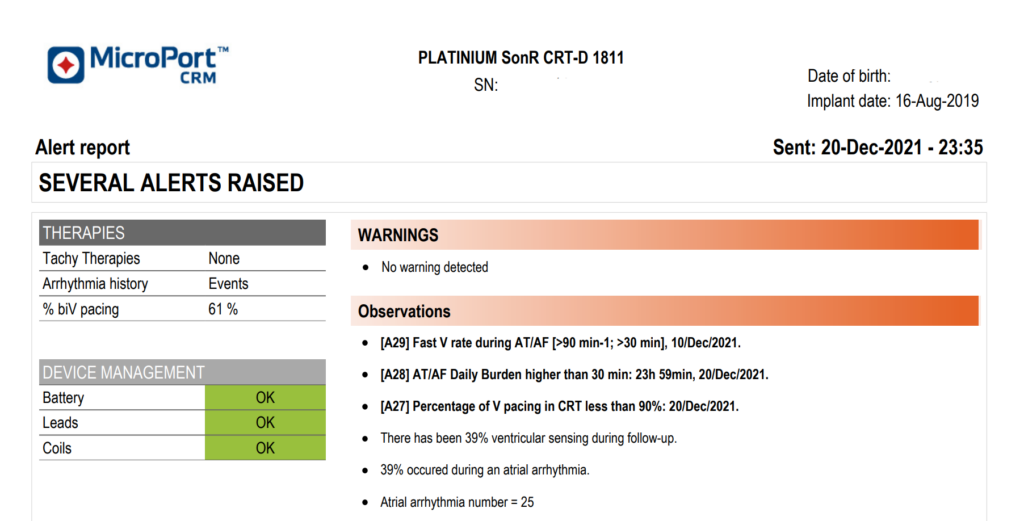Benefits of remote monitoring of CRT
Remote monitoring is indispensable for patients with cardiac resynchronization therapy (CRT), a specialized treatment for individuals with heart failure and electrical conduction abnormalities. By utilizing remote monitoring, healthcare providers can closely track and manage patients with CRT devices, leading to better outcomes and enhanced patient care. In this lesson, we will explore the crucial reasons why remote monitoring is essential for CRT patients.
A remote monitoring tranmission revealing a decreased CRT delivery due to the onset of atrial fibrillation with rapid ventricular response.
Early Detection of Lead Issues
One of the primary reasons for remote monitoring in CRT patients is the early detection of lead issues. CRT devices are implanted to improve cardiac function and manage heart failure. In order to do so, the left ventricular (LV) lead needs to properly capture the heart. The right atrial (RA) and the right ventricular (RV) lead also need to properly sense events and have proper capture. Remote monitoring allows healthcare providers to continuously assess the performance of the CRT device, ensuring it functions optimally. When CRT is not properly applied, one of possible the etiologies is a lead issue (such as atrial undersensing) which can be directly responsable for the diminished CRT delivery. Through remote monitoring, device data, such as lead status and integrity can be reviewed regularly. Any irregularity or malfunction can be detected promptly, reducing the risk of lead-related complications. This early detection not only prevents potential life-threatening situations but also minimizes the need for emergency procedures and hospitalizations.
Monitoring CRT delivery
CRT devices are highly customizable to meet the unique needs of each patient. Remote monitoring enables healthcare professionals to make timely adjustments to the device settings. Suboptimal CRT delivery of under 90-95% is associated with increased risk of developing heart failure. Remote monitoring is crucial because the patient’s condition can rapidly change over time when CRT is not applied, necessitating rapid alterations in device programming to optimize therapy. Most commonly, onset of AF or premature ventricular complexes are responsable for loss of CRT. However a multitude of etiologies are possible. For example, remote monitoring may reveal that the programmed atrioventricular delay is programmed too long, allowing for fusion with intrinsic conduction and loss of CRT efficacy. Reprogramming of the AV delay (shortening) can increase CRT delivery and decrease the risk of developing symptoms associated with heart failure.
Monitoring Battery Status
Another critical aspect of remote monitoring for CRT patients is the continuous assessment of the device’s battery status. CRT devices rely on batteries for power, and these batteries have a limited lifespan, typically ranging from five to ten years. Monitoring the battery status remotely allows healthcare providers to predict when the battery will reach its end of life accurately. When the battery is nearing depletion, proactive steps can be taken to replace the device, preventing sudden loss of resynchronization. This proactive approach ensures that the patient remains protected and prevents unnecessary complications or emergencies associated with battery depletion.
Detection of Arrhythmias and Heart Failure Status
Patients receiving CRT often have a history of arrhythmias, which can be life-threatening. Remote monitoring is a valuable tool for detecting arrhythmias promptly. The device continuously records the patient’s cardiac rhythm and can automatically transmit this information to healthcare providers if an abnormal rhythm is detected. Additionally, heart failure patients can experience fluctuations in their condition, leading to symptoms such as fluid retention and shortness of breath. Remote monitoring allows healthcare providers to assess the patient’s heart failure status through parameters like intrathoracic impedance, heart rate, patient activity and others. Any signs of worsening heart failure can be identified early, facilitating timely interventions such as medication adjustments or lifestyle modifications.
Reducing Hospitalizations and Healthcare Costs
Remote monitoring has a profound impact on reducing hospitalizations and associated healthcare costs for CRT patients. By closely monitoring CRT patients remotely, healthcare providers can identify issues early and intervene before they worsen. This proactive approach leads to a significant reduction in hospital admissions, emergency room visits, and unscheduled clinic appointments. Hospitalizations for heart failure exacerbations are not only emotionally and physically taxing for patients but also place a significant financial burden on healthcare systems. Remote monitoring helps alleviate this burden by preventing unnecessary hospitalizations and promoting more efficient use of healthcare resources. Moreover, remote monitoring is cost-effective in the long run. While there may be initial setup costs and investments in remote monitoring infrastructure, the long-term savings generated through reduced hospitalizations and clinic visits outweigh these expenses. Patients also benefit from the convenience of fewer medical appointments and reduced travel costs associated with in-person visits.
In conclusion, remote monitoring is essential for patients with cardiac resynchronization therapy. It ensures the early detection of device issues, facilitates timely adjustments of device settings, monitors battery status, detects arrhythmias and heart failure status, and reduces hospitalizations and healthcare costs. Embracing remote monitoring not only improves patient outcomes and quality of life but also promotes efficient healthcare delivery, making it a vital component of CRT patient care.


